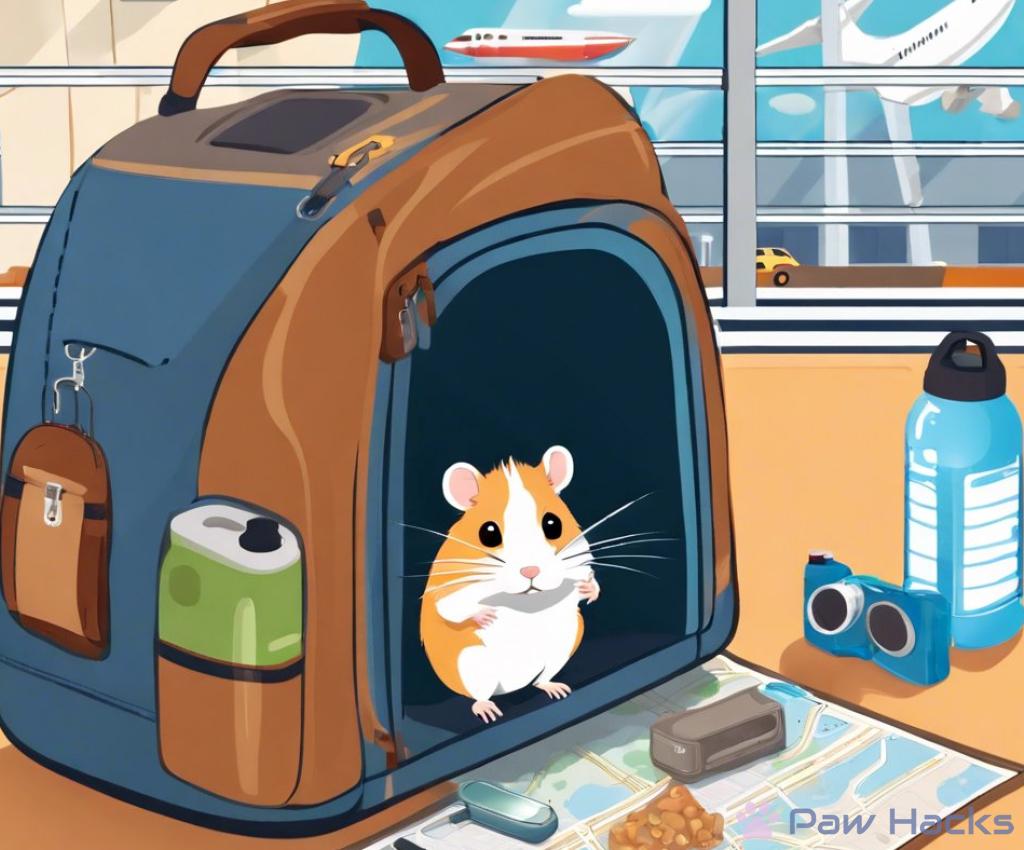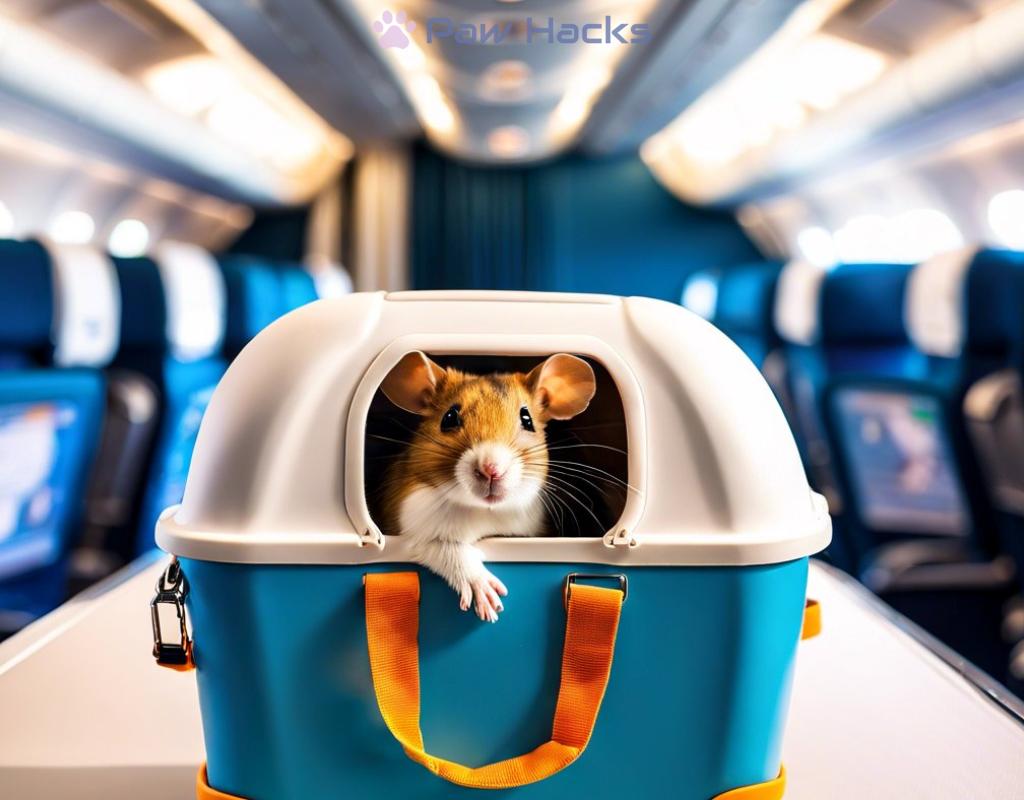Flying with Pet Rodents
Essential Tips for Traveling with Your Beloved Rodents

Traveling with your pet rodents requires careful preparation to ensure a smooth and stress-free experience for both you and your furry friends. Before you even reach the airport, there are steps you can take to make the journey easier.
- Choose the Right Carrier: Make sure to select a well-ventilated, secure carrier that accommodates your rodent’s size.
- Health Check: Consult your veterinarian to ensure your pets are fit for travel.
- Familiarize Them with the Carrier: Allow your rodents to explore the carrier at home before the trip.
When you’re in the air, the environment changes drastically for your rodents. Keeping them comfortable and safe is crucial during this phase of travel.
- Keep the Carrier Secure: Always ensure the carrier is fastened and won’t move during the flight.
- Maintain Calm: Speak softly to your rodents to keep them relaxed.
- Monitor Temperature: Ensure the area around the carrier is not too hot or cold.
Once you land, it’s important to help your pet rodents adjust to their new environment. A few simple strategies can make a big difference in their comfort level.
| Action | Description |
|---|---|
| Set Up a Temporary Habitat | Quickly create a safe space for your rodents with familiar bedding and food. |
| Hydration | Ensure your pets have access to fresh water immediately after the flight. |
| Observation | Watch for any signs of stress or illness after the journey. |
Choosing the Right Carrier: A Guide for Pet Rodents
When preparing for air travel with your pet rodents, selecting the ideal carrier is one of the most critical decisions you’ll make. The right carrier not only ensures your rodent’s safety but also contributes to their comfort during the flight. With various options available, understanding what to look for can simplify your choice and lead to a more enjoyable journey for both you and your furry companions.
Before purchasing a carrier, it’s essential to consider the specific needs of your pet rodents. Look for carriers that provide ample ventilation, as rodents require fresh air to remain calm and comfortable. A carrier constructed from durable materials is also important, as it should withstand any movement during transit. Furthermore, the carrier’s size matters significantly; it should be spacious enough for your rodent to stand up, turn around, and lie down without feeling cramped. This extra space can help alleviate anxiety and keep your pet relaxed throughout the trip.
In addition to size and ventilation, prioritize safety features in your carrier. A secure latch mechanism is crucial to prevent accidental escapes, which can lead to dangerous situations in an unfamiliar environment. Consider carriers with a solid base to provide stability and minimize the risk of tipping over during the flight. Additionally, it’s wise to choose a carrier with a smooth interior to avoid any injuries to your pet while they move around. Investing in a carrier with these features will give you peace of mind as you travel.
Once you’ve chosen the right carrier, it’s time to make it a comfortable environment for your rodents. Before the trip, allow them to explore the carrier at home; this helps them become accustomed to their new space. Place familiar bedding and toys inside to create a sense of security. If your rodents are used to their surroundings, they’re less likely to feel stressed during the flight. Remember, a well-adjusted pet is more likely to travel peacefully, making your journey enjoyable.
Understanding Airline Policies for Rodent Travel
Traveling with your pet rodents can be an incredible adventure, but it’s vital to understand the specific airline policies that apply to their travel. Each airline has its own regulations regarding the transportation of small animals, and being informed can save you from unexpected surprises at the airport. Knowing these guidelines can also help ensure a smoother journey for you and your furry companions.
Before booking your flight, take the time to thoroughly research the airline’s pet travel policies. Many airlines have detailed sections on their websites dedicated to traveling with pets. These sections often include important information about carrier specifications, health documentation, and fees associated with traveling with your rodents. Additionally, you may want to contact the airline directly to clarify any specific questions you may have.
Most airlines charge fees for transporting pets, which can vary significantly between carriers. Understanding these costs upfront can help you budget for your trip. In addition to fees, some airlines may have restrictions on the number of pets allowed in the cabin or may require advance reservations for pet travel. Be sure to review the airline’s policy on the types of rodents allowed, as certain breeds or sizes may be prohibited.
Many airlines require proof of health certificates for your rodents, which must be issued by a licensed veterinarian. This documentation typically confirms that your pet is healthy and up-to-date on vaccinations. It’s advisable to schedule a vet visit well in advance of your trip to ensure you have all necessary paperwork. Furthermore, familiarize yourself with any quarantine regulations at your destination, as some areas may have specific requirements for bringing in animals.
Key Points to Consider:
- Review the airline’s pet travel policy.
- Prepare for associated fees and restrictions.
- Obtain necessary health documentation from a veterinarian.
- Check for any quarantine regulations at your destination.
By taking these steps, you can ensure that you and your beloved rodents are well-prepared for your flight. Understanding airline policies will help you navigate the process smoothly and make your travel experience enjoyable.
Preparing Your Pet Rodent for a Stress-Free Journey
Traveling with your pet rodents can be a rewarding experience, but it also requires thoughtful preparation to ensure they feel secure and comfortable throughout the journey. By taking proactive steps before the flight, you can significantly reduce the stress for both you and your furry companions. Here are some essential strategies to help your rodents acclimate and enjoy the trip.
Before the travel day arrives, it’s important to create a peaceful and familiar environment for your rodents. This can significantly ease their anxiety and help them feel safe during transit.
- Familiarization: Gradually introduce your rodents to the carrier. Leave it open in their living area for a few days, allowing them to explore it freely. Add their favorite bedding and toys to create a welcoming space.
- Routine Adjustment: In the week leading up to your trip, try to maintain their routine as much as possible. This includes feeding schedules and playtime, so they feel secure and accustomed to their daily lives.
- Desensitization to Noise: Since airports and airplanes can be loud, consider playing recordings of travel sounds at a low volume at home. This can help your rodents become accustomed to the noise they might encounter.
Ensuring your rodents are healthy and secure is crucial for a successful journey. Taking the time to prepare their health and safety will give you peace of mind during travel.
- Veterinary Check-Up: Schedule a visit to the vet to ensure your rodents are healthy and ready for travel. Discuss any concerns and ask for tips on keeping them calm during the journey.
- Health Documentation: Obtain health certificates as required by the airline. These documents prove that your pets are in good health and up to date on vaccinations.
- Emergency Kit: Pack a small emergency kit that includes items like extra food, water, and a familiar blanket. This can help comfort your rodents if they become anxious during travel.
By taking these proactive steps, you can prepare your pet rodents for a stress-free journey. The key is to focus on their comfort, health, and familiarity with their surroundings, which can transform your travel experience into a positive adventure.
Health and Safety: Keeping Your Rodents Happy While Flying
Traveling by air with your furry friends can be a delightful experience, but it also comes with its own set of challenges, especially regarding their health and safety. Ensuring that your pet rodents are comfortable and secure during the flight is paramount. With the right preparations and precautions, you can create a positive travel experience that minimizes stress and maximizes their happiness.
Before embarking on your journey, it’s essential to focus on your rodents’ health. Ensuring they are fit for travel not only protects their well-being but also allows you to enjoy your trip without worry. Here are some key steps to take:
- Veterinary Consultation: Schedule a check-up with your veterinarian to assess your rodents’ health. Discuss any specific concerns you may have regarding their travel.
- Health Certificates: Many airlines require a health certificate issued by a vet, confirming that your pets are in good health and up-to-date on vaccinations.
- Emergency Plan: Prepare a plan in case of unexpected health issues during the flight. Carry a list of emergency contacts, including your veterinarian’s phone number.
Once you’ve taken the necessary health precautions, the next step is to ensure your rodents feel safe and comfortable during the flight. A familiar environment can significantly reduce their anxiety levels:
- Comfort Items: Pack a few comfort items like their favorite blanket, toys, or bedding to provide a sense of familiarity.
- Hydration: Make sure to provide access to water before and during the flight to keep your rodents hydrated.
- Monitoring Behavior: During the flight, keep a close eye on your rodents. Look for signs of stress or discomfort, such as excessive scratching or vocalizing, and be ready to comfort them.
After you land, it’s crucial to perform a health check on your rodents. The transition to a new environment can be overwhelming for them:
- Immediate Check: Inspect your rodents for any signs of stress or illness once you arrive at your destination.
- Temporary Habitat Setup: Quickly set up a safe, familiar space for them with their bedding and toys to help them adjust.
- Gradual Acclimatization: Allow your rodents time to acclimate to their new environment at their own pace, providing comfort and reassurance throughout the process.
By focusing on these health and safety measures, you can help ensure that your pet rodents have a pleasant and enjoyable flying experience. Remember, the happier they are, the more enjoyable your journey will be!
Share this content:



